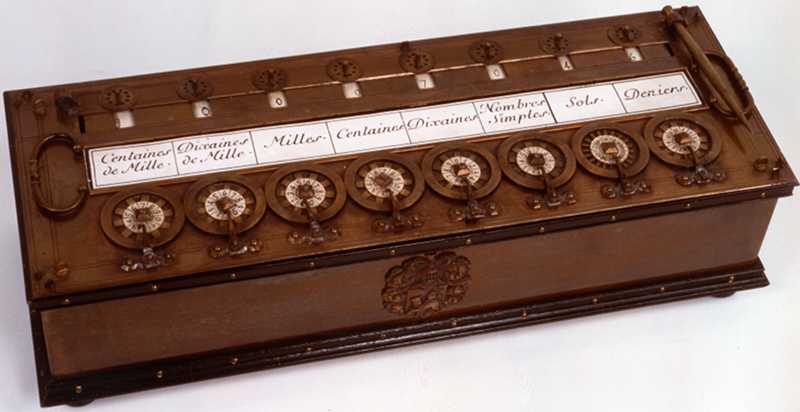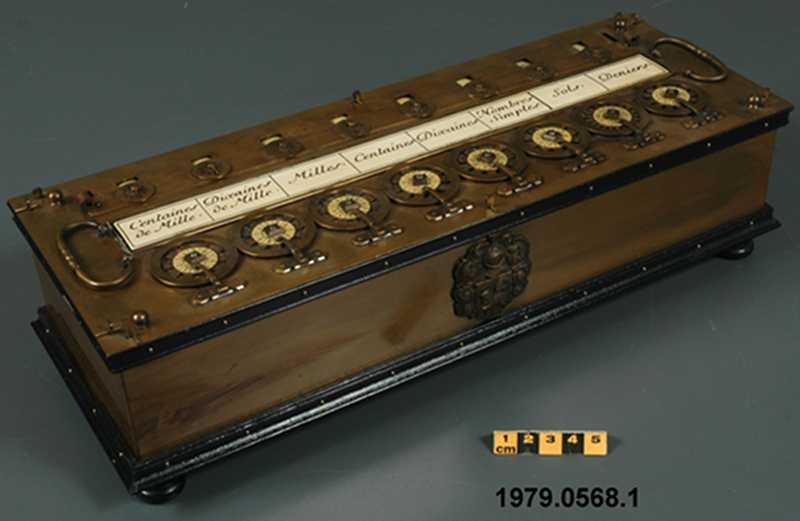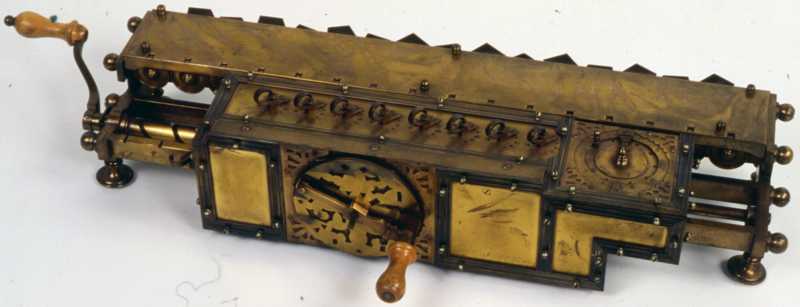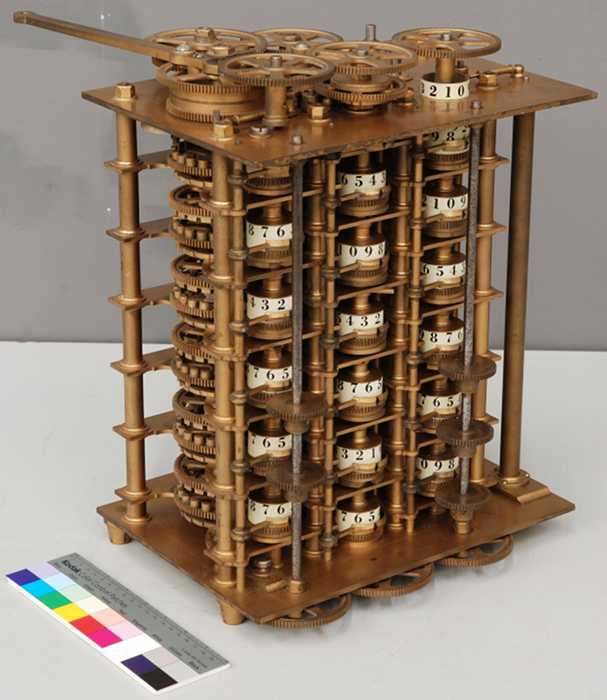
The engineer Roberto A. Guatelli manufactured many replicas for IBM, Digital Equipment Corporation, and other customers (for details, see The Model Maker of Leonardo da Vinci, Blaise Pascal, and Charles Babbage.
In 2018, Parmela McCorduck donated to Carnegie Mellon University (CMU) a collection of calculating machines, including an early Thomas Arithmometer, a three-rotor and a four-rotor Enigma, and a Guatelli replica of the Millionaire direct multiplier. In December 2018, I was trying to find out more about the Italian model maker. A few days ago, Mary Catharine Johnsen from CMU let me know that their collection also comprises Guatelli rebuilds of Pascal, Leibniz, Adix and Webb.
The Traub-McCorduck Collection, which is home to five Guatelli reproductions, is named in honor of Parmela McCorduck’s late husband, the computer science pioneer Joseph Traub. In 1988, the couple bought the five replicas from Guatelli.
Guatelli replicas can also be found in Milan, Italy; Mountain View, CA; New York, and Ottawa, Canada (see Figs. 1-4).
Pascal, Leibniz, and Babbage
The first mechanical calculating machines were invented in the 17th century by Wilhelm Schickard, Blaise Pascal, and Gottfried Wilhelm Leibniz. Schickard’s calculating clock, which was destroyed by fire, used Napier rods.
Eight Pascalines have been preserved; they are located in Paris and Clermont-Ferrand, France; Dresden, Germany, and New York. The Pascaline is an addition and subtraction device.
The only surviving copy of the Leibniz calculator dates from the 1690s, and is kept in Hannover, Germany. Leibniz’s calculator was the world’s first mechanical calculating machine capable of all four basic operations (for details, see Meilensteine der Rechentechnik).
In order to produce error-free mathematical tables, Charles Babbage designed two difference engines, which remained unfinished. The original machine is in London.
I am hoping to get additional photos and to receive more details on surviving Leonardo da Vinci models and replicas of calculating devices
Fig. 1: Reproduction of the Pascaline by Roberto Guatelli 1.
The machine. built by Blaise Pascal (1623–1662), is able to process values up to 999 999 livres.
(1 livre has 20 sols, 1 sol 12 deniers)
Credit: Museo nazionale della scienza e della tecnologia “Leonardo da Vinci,” Milan, Italy.
Fig. 2: Reproduction of the Pascaline by Roberto Guatelli 2.
Pascal built the first machine in 1642.
Credit: Canada Science and Technology Museum, Ottawa, Canada, object number 1979.0568.001.
Fig. 3: Reproduction of the Leibniz calculator by Roberto Guatelli.
Gottfried Wilhelm Leibniz (1646–1716) built his first calculating machine in 1673.
Credit: Museo nazionale della scienza e della tecnologia “Leonardo da Vinci,” Milan, Italy.
Fig.4: Reproduction of Babbage’s difference engine by Roberto Guatelli.
In 1822, Charles Babbage (1792–1871) began developing his first difference engine.
Credit: Canada Science and Technology Museum, Ottawa, Canada, object number 2011.0022.001.
Guatelli replicas of calculating machines
Carnegie Mellon University, Pittsburgh, PA (Traub-McCorduck Collection)
- Pascaline
Replica. Several different originals (1642 and later) have survived (e.g., in Paris, Clermont-Ferrand, Dresden). - Gottfried Wilhelm Leibniz’s calculator (c. 1694).
The only preserved original is in the Gottfried-Wilhelm-Leibniz Library in Hannover, Germany. - Charles Henry Webb’s adding machine, New York
Webb patented his machine in 1868. It was operated with a pen. - Key-driven adding machine of the Adix Company, Mannheim, Germany.
The inventor of this single digit adder was Josef Pallweber of Mannheim (patent 1904). The portable ratchet machine was manufactured by Adolf Bordt of Mannheim. - Millionaire
The first Millionaire of H.W. Egli Ltd., Zurich, was constructed in 1893. This machine with serial number 2380 was produced around 1916. The machine was invented by the Swiss engineer Otto Steiger.
IBM Corporate Archives, Poughkeepsie, New York
In the IBM archives, you can find several Guatelli replicas (including the Pascaline). It is not known who is the author of the calculating machines of Leibniz, Leupold/Braun/Vayringe, Morland, the analytical and the difference engines of Charles Babbage, the difference engine 2 of Edvard and Pehr Scheutz. Unfortunately no information is available.
Leonardo da Vinci models
Guatelli was engaged from 1951 to 1961 for Thomas J. Watson Sr., the founder of IBM; after that, he opened a workshop in New York. According to Jim Strickland, Guatelli’s nephew, Joseph Mirabella began working with IBM in 1964. He continued the business after Guatelli’s death until 2005. Mirabella had donated the Da Vinci models to the Long Island Science Center, Riverhead, New York. Nathan Myhrvold of Intellectual Ventures is said to have acquired the remaining replicas of calculating machines. Further information is still pending.
Heydenreich’s book Leonardo da Vinci, to which Watson has written an epilogue, contains (apart from illustrations of the Mona Lisa and the Last Supper) numerous sketches of the universal genius, among them: anemometer, Archimedean screw and wheel, automatic drum, clock mechanism, coin stamper, diver’s apparatus, dome, double hull for a ship, excavation machine, flying machine (ornithopter), helicopter, hydraulic pump, hydraulic screw, jack, lens grinder, machine gun, military port, military tank, odometer, parachute, printing press, projector, rotating bridge, screw-cutting machine, self-propelled ship, spring-driven car, transmission (differential), two-level bridge, and ventilator.
There are some museums with Leonardo da Vinci models, such as those in Vinci, Florence, and Milan, Italy. Handmade replicas by Roberto Guatelli and Joe Mirabella are exhibited at the Long Island Science Center, Riverhead, NY. According to Marta Montagnaro in the Museo Leonardiano di Vinci, there is only one Guatelli model in that museum: the Carro automotore (self-propelled car), 1952.
In the IBM Corporate Archives in Poughkeepsie, NY, the following Leonardo da Vinci models made by Guatelli are held: mobile mechanical music drum, flying machine, helicopter, odometer, paddlewheel ship, scaling ladder.
References
Bruderer, Herbert: Meilensteine der Rechentechnik, De Gruyter Oldenbourg, Berlin/Boston 2018, 2 volumes, 1600 pages (Milestones in Analog and Digital Computing, 3rd English edition forthcoming)
https://www.degruyter.com/view/product/480555
https://www.degruyter.com/view/product/503373
Buchwald, Jed; Stewart, Larry (eds.): The Romance of Science: Essays in honour of Trevor H. Levere, Springer International Publishing AG, Cham, Switzerland 2017, ix, 310 pages.
Fleck, Glen: A Computer Perspective, Harvard University Press, Cambridge, MA, 1973, 174 pages (Exhibition designed by the office of Charles and Ray Eames, IBM Exhibit center, New York City)
Heydenreich, Ludwig Heinrich: Leonardo da Vinci, the Scientist, Collections of the Department of Arts and Sciences, International Business Machines Corp., New York 1951, 23 pages (epilogue by Thomas J. Watson Sr.).
Kaplan, Erez: The Controversial Replica of Leonardo da Vinci’s Adding Machine, in IEEE Annals of the History of Computing, 1997, Volume 19, issue 2, pages 62–63.
Moon, Francis Charles: The Machines of Leonardo da Vinci and Franz Reuleaux. Kinematics of Machines from the Renaissance to the 20th Century, Springer, Dordrecht 2007, xxxiii, 417 pages (chapters: Models as the new “Theatre Machines,” pages 199–211; Ancient Greek and Roman Machines, pages 107–115).
Pantalony, David: Collectors, Displays, and Replicas in Context: What We Can Learn from Provenance Research in Science Museums, in: The Romance of Science: Essays in Honour of Trevor H. Levere, Jed Buchwald, Larry Stewart (eds.), Springer International Publishing AG, Cham 2017, pages 268–274.
Strickland, Jim: Who was that guy? Roberto Guatelli, in Computer History Museum, Mountain View, CA, Volunteer Information Exchange, Volume 2, No. 3, 15 February 2012
Acknowledgements
Many thanks to all people involved: Lawrence Fisher, Vincenzo Iannone, Mary Catharine Johnsen, Peggy Aldrich Kidwell, Karen Martin, Pamela McCorduck, Marta Montagnaro, David Pantalony, Paola Redemagni, Andrew Rosenbloom, Ed Thelen, and Keith Webster.
Herbert Bruderer is a retired lecturer in didactics of computer science at ETH Zürich. More recently, he has been an historian of technology. bruderer@retired.ethz.ch, herbert.bruderr@bluewin.ch







Join the Discussion (0)
Become a Member or Sign In to Post a Comment